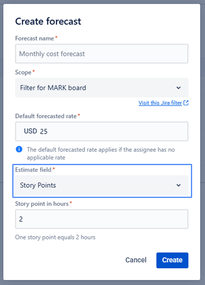Community resources
Community resources
Community resources
From Story Points to Cost: Forecasting IT Consulting Project Budgets
Why forecasting matters in IT consulting
Consulting teams often deliver custom development projects for multiple clients at once. Each project is unique — different scope, duration, and complexity. But for every client, one key question always arises:
👉 “How much will this project cost, and what could change along the way?”
Teams usually estimate tasks in Story Points, which works well for measuring effort but not for budgeting. To plan effectively, project managers need to translate those Story Points into time and cost forecasts. This ensures:
- realistic budgeting,
- transparent communication with stakeholders,
- reduced risk of unexpected expenses,
- better profitability control.
This is where Time & Cost Tracker for Jira comes in handy — helping you forecast budgets early, even if your team estimates in Story Points.
🎯 Goals
- Plan costs early — forecast budgets during the planning phase.
- Bring transparency — present clients with realistic financial expectations.
- Control profitability — compare forecasted vs. actual project costs.
⚙️ Workflow
Step 1. Create a budget forecast
- Estimate the backlog in Story Points
- Start by reviewing all tasks in your project backlog.
- The team assigns Story Points (SP) to each task based on effort, complexity, and time required.
- Story Points allow teams to standardize effort measurement across tasks.
- Define a conversion rate from SP to hours
- Decide how many hours one Story Point represents.
- Example: 1 SP = 2 hours.
- This conversion makes it possible to translate agile estimates into actual time and cost.
- Open Time & Cost Tracker in Jira.
- Go to the Forecasts section of the app and click Create forecast to start a new budget prediction.
- Fill in the forecast details:
- Forecast name: Give your forecast a meaningful, descriptive name (e.g., “Website Redesign Q4 Budget”).
- Scope: Select a Jira filter that contains the issues you want to include in this forecast. This allows you to focus on a specific project, sprint, or set of tasks.
- Default forecasted rate: Set an average hourly rate for your team or project. This will be used to calculate cost.
- Estimate field: Choose whether the forecast will use Story Points or the Original Estimate field from Jira.
- Story point value: Enter how many hours equal 1 Story Point.
💡 Example: If 1 SP = 2 hours, the forecast will calculate the total time and cost based on this conversion.
Step 2. Review your forecast
Once created, the forecast translates Story Points into a cost estimate.
- Both Story Point values and hourly rates can be updated anytime.
- The forecast recalculates dynamically whenever values change.
👉This flexibility is especially useful when project scope or resources shift during planning.
Step 3. Forecast formula
The formula behind the forecast is straightforward:
🧮 Forecast Cost = (Hours per Story Point × Number of Story Points × Hourly Rate)
👉 Example:
- 1 SP = 3 hours
- Task = 8 SP
- Hourly rate = $50
3h × 8 SP × $50 = $1,200
📈 Outcomes
- For PMs: early visibility into overall costs and resource allocation.
- For stakeholders: clear understanding of budget risks before the project even starts.
- For clients: transparent, data-based cost forecasts.
- For the company: improved profitability tracking across multiple projects.
✨ By using Time & Cost Tracker for Jira, IT consulting teams can forecast budgets with precision, improve planning, and build stronger trust with clients through financial transparency.
📅 Try Time & Cost Tracker for Jira Cloud on the Atlassian Marketplace
Was this helpful?
Thanks!
Anastasiia Maliei SaaSJet




0 comments